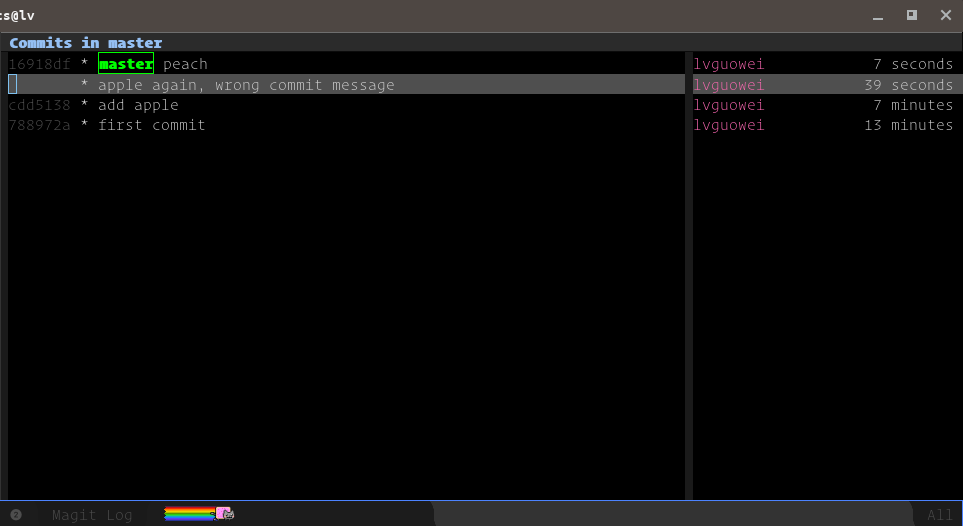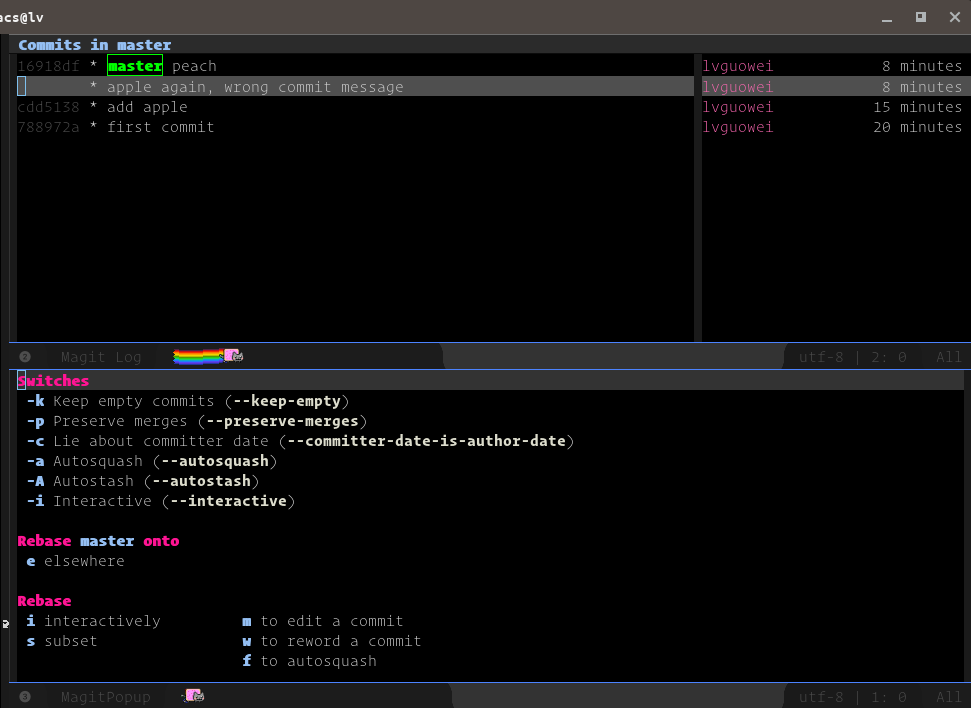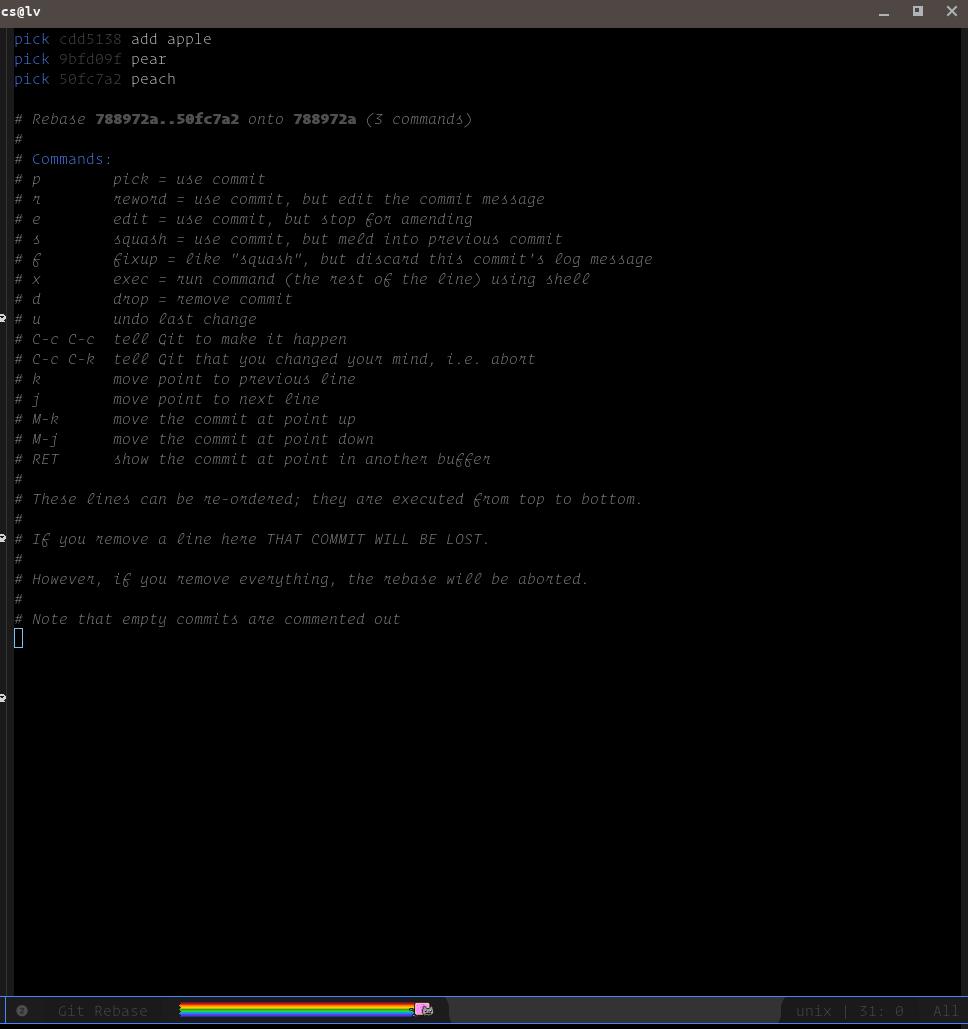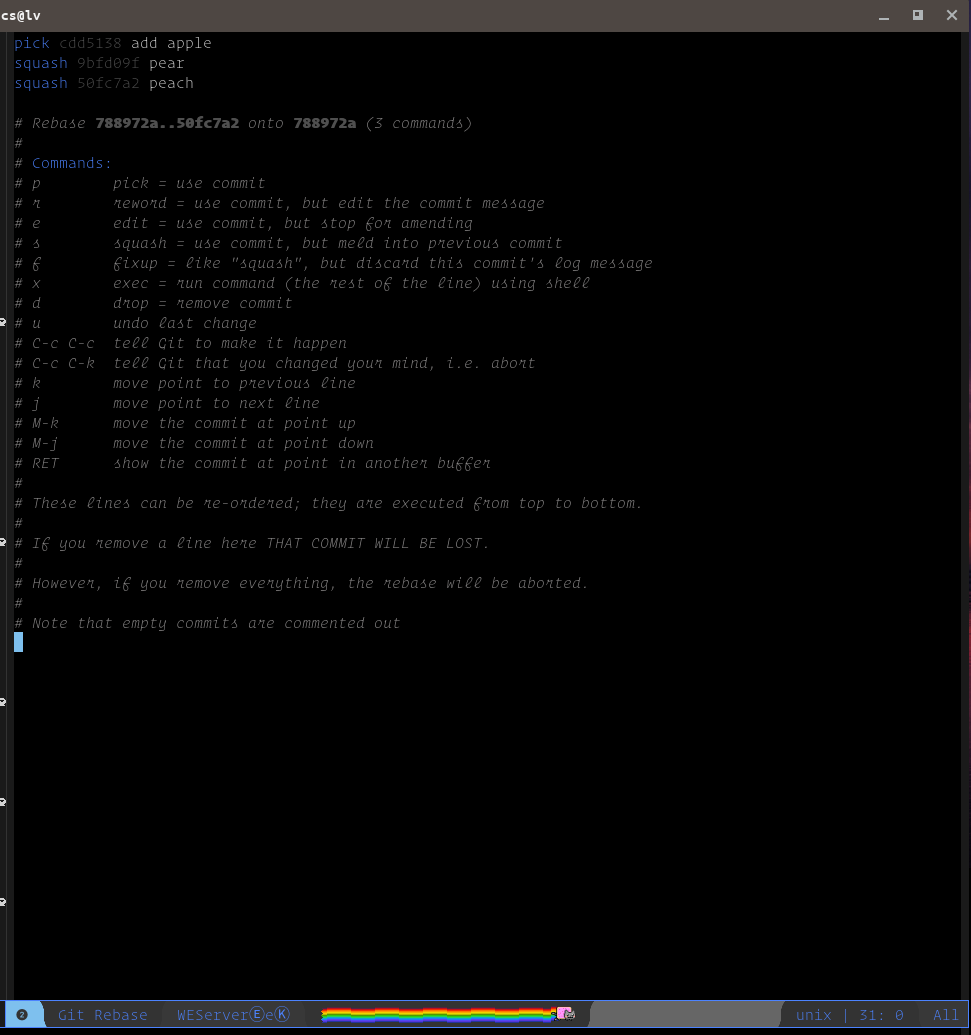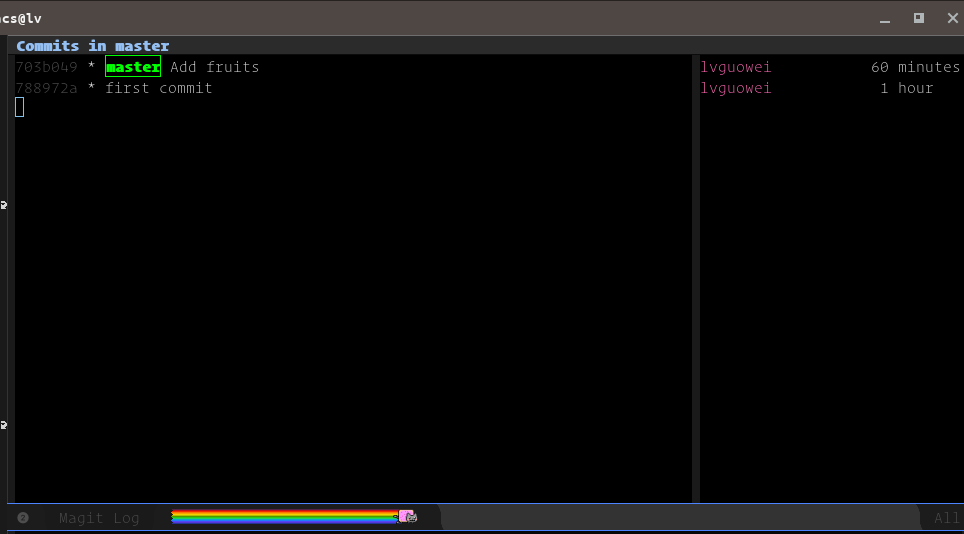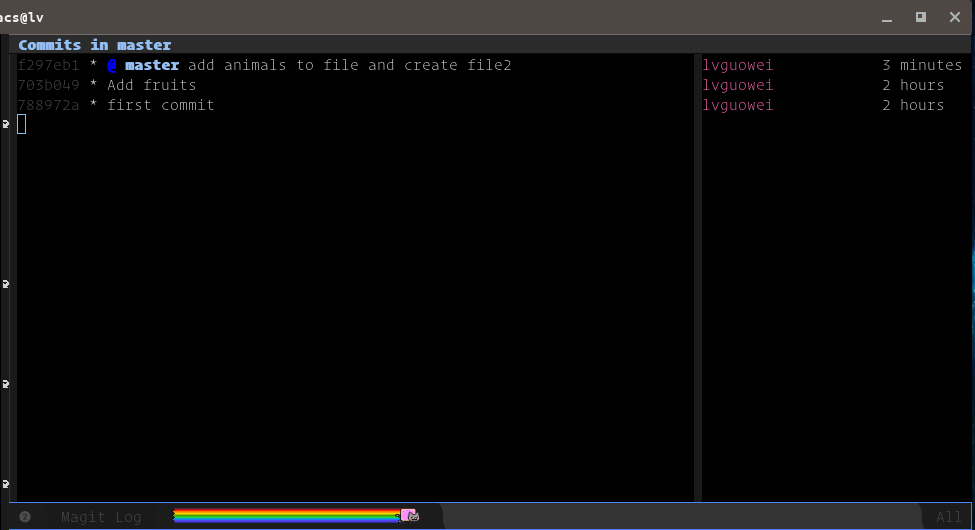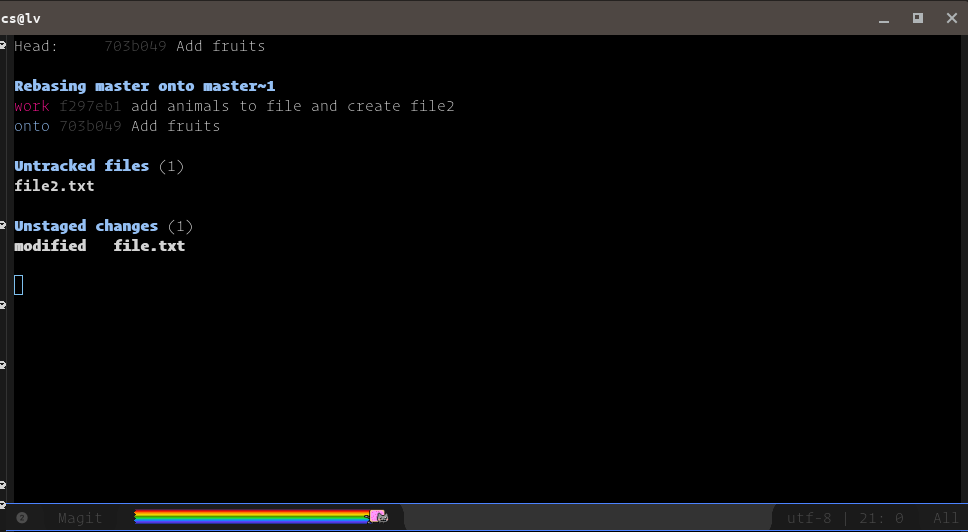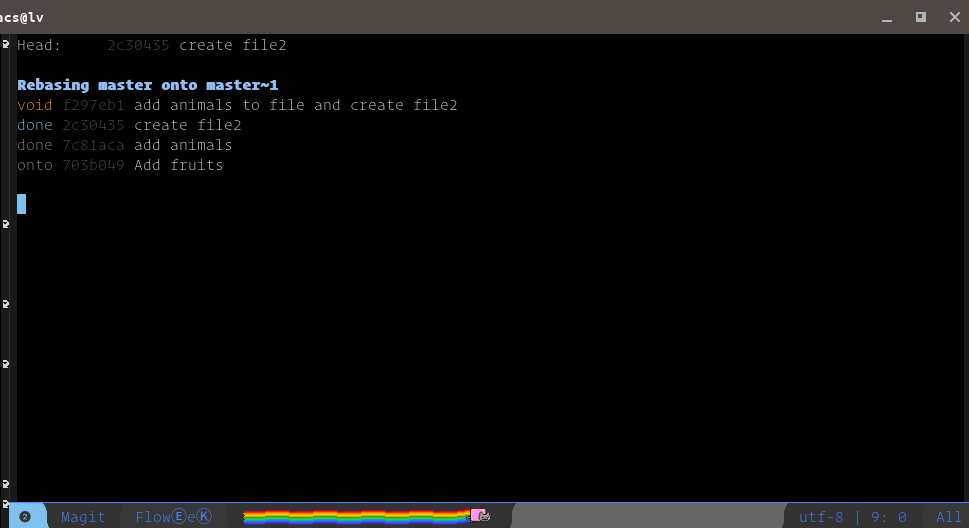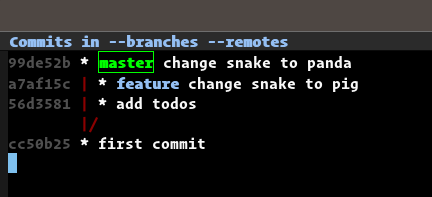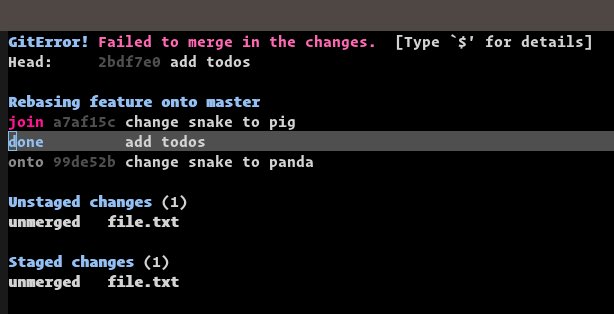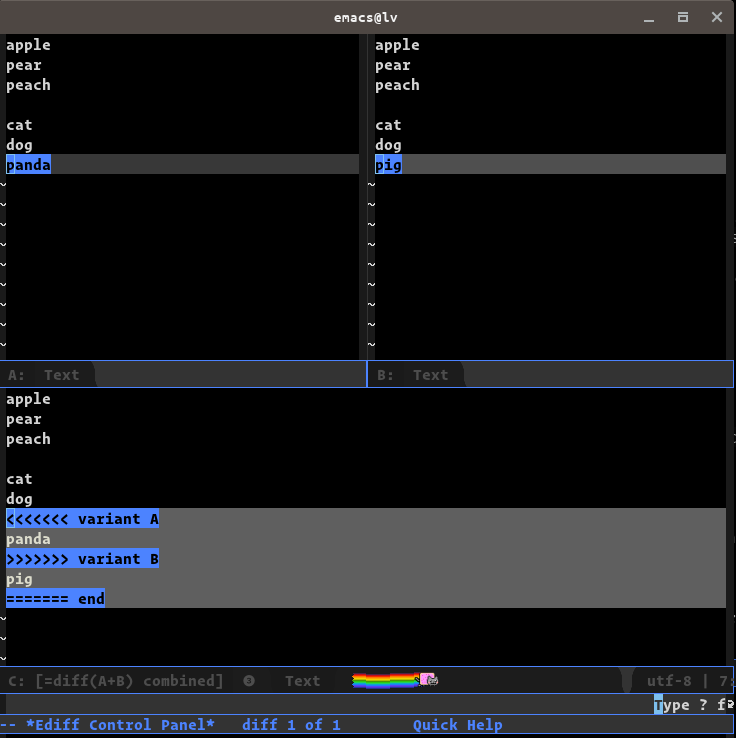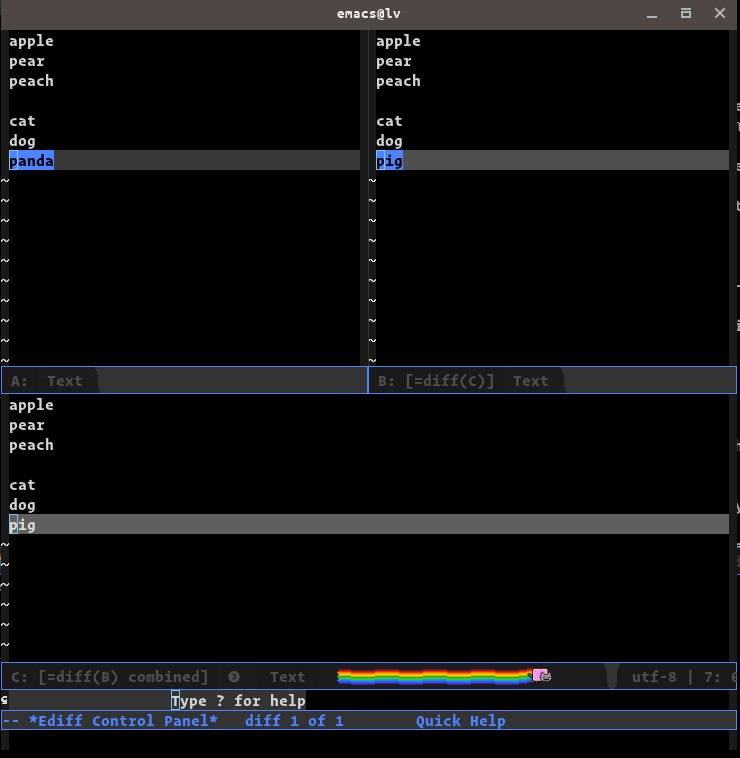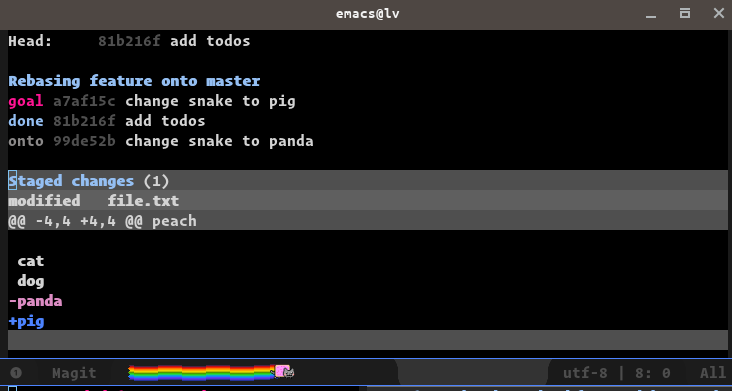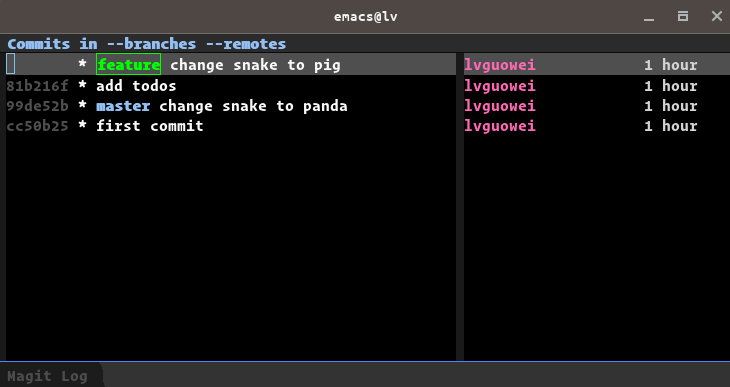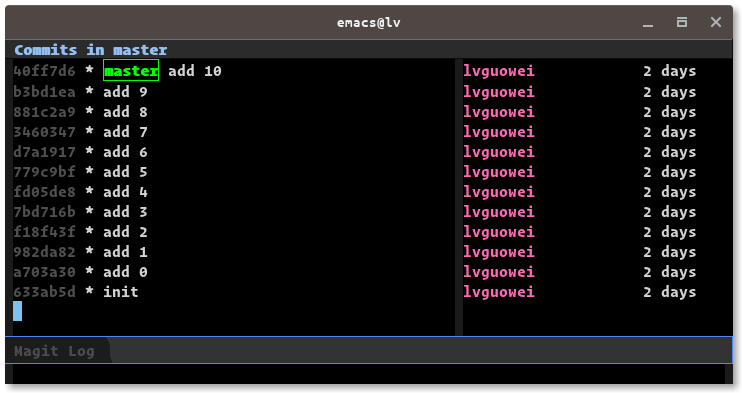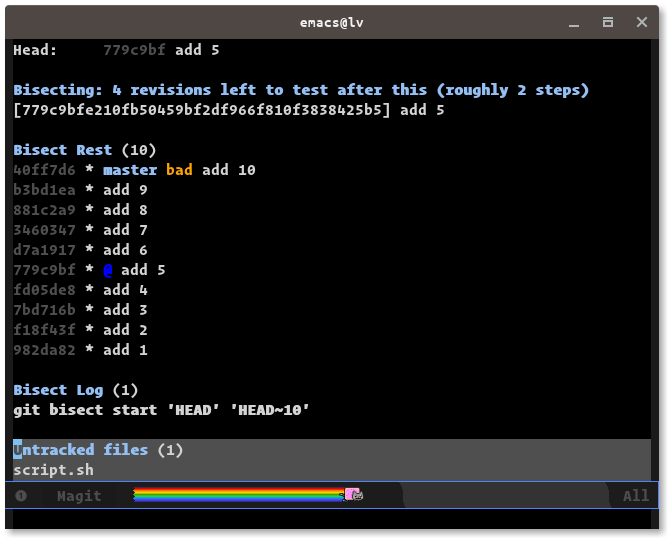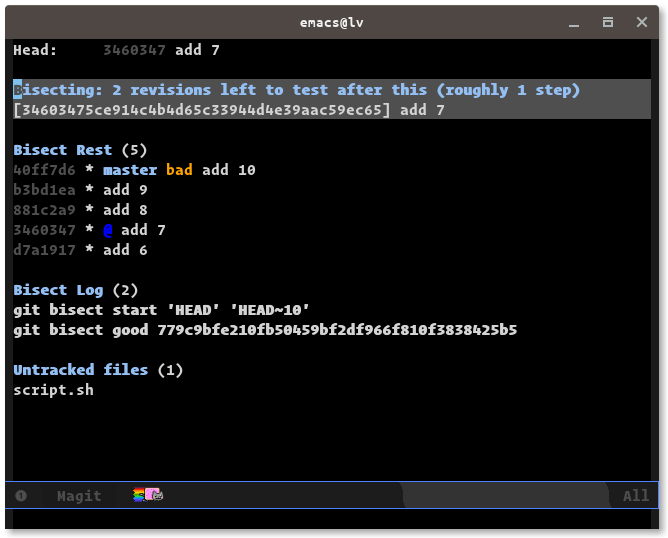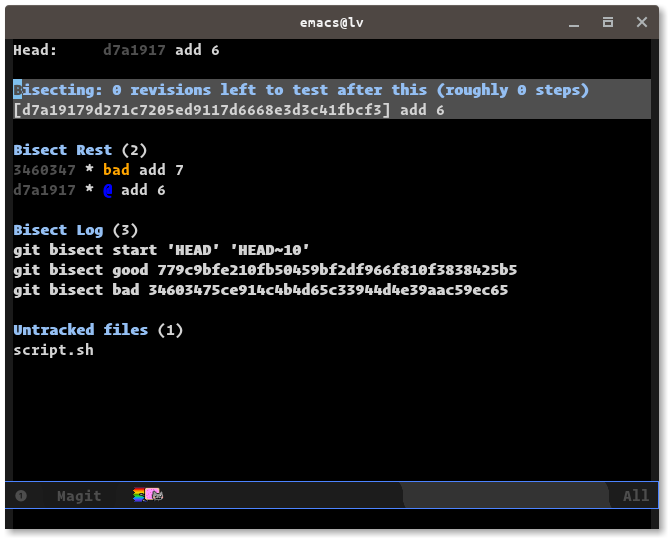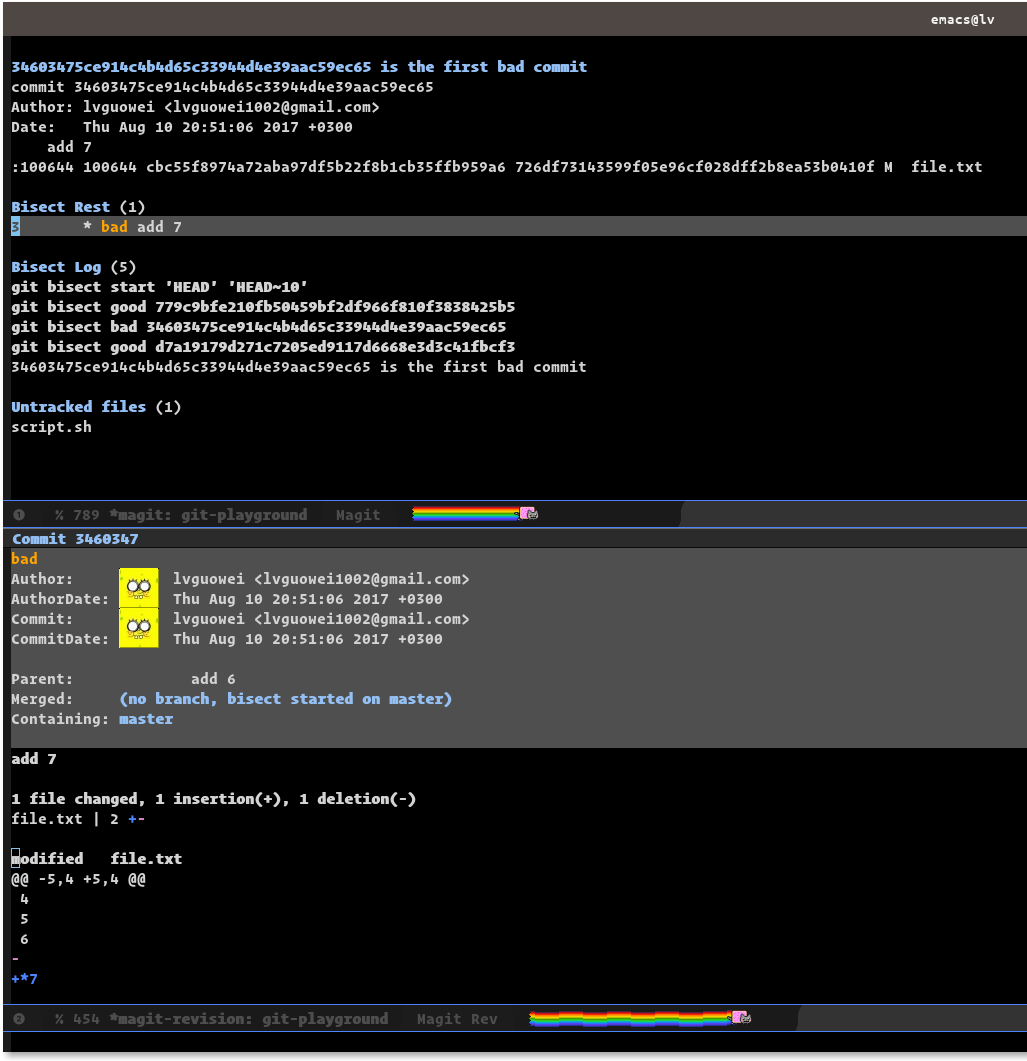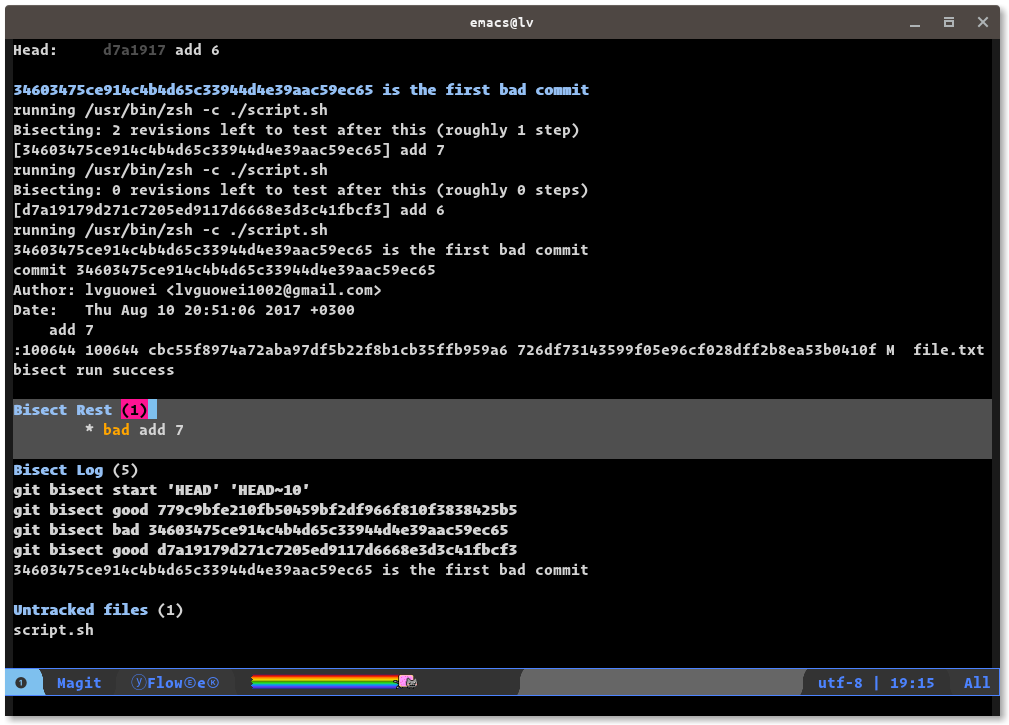[2021-04-04 Sun 17:29]
*Magit* is arguably the best Git tool out there and also my favorite. It is a package in Emacs, and it is text based. In this tutorial, we will explore how to use it to tackle one of the more elusive topics in Git: Rebase.
Let’s create an empty repository and add one empty file to it.
git init touch file.txt git add . git commit -m 'first commit'
Now let’s add some fruits in the file. Open the file and add a new line
apple
Open Magit, commit the change with a message says
Add apple
Then add a new line
pear
with commit message
apple again, wrong commit message
Then add a new line
peach
with a commit message
peach
Now it is clear that we need to fix the second commit message. But since this is not the last one we cannot use git commit --amend. But we can still use rebase to change it.
In Magit, press ll to open the log history. Put the cursor under the wrong commit.
Then press =r=(rebase) and =w=(to reword a commit).
Now enter the correct commit message pear and press C-c C-c. Now you should see the commit messages updates.
It appears that the last 3 commits should really be 1 commit with a message like add fruits. We can use rebase to squash them into one commit like this:
In the commit history, put the cursor on the oldest of the 3 commits that we want to squash, and press =r=(rebase) =i=(interactively). We now see the interactive rebase page.
The good thing about this page is that it contains a cheatsheet already, so you can just see what kind things can be done here.
Notice that the order of the commits now is reversed, the latest commit being at the bottom.
As the cheatsheet says, we can put the cursor on the pear commit and press s, this means that we want this commit to be squashed into its previous commit. And then we do the same for the peach commit.
We can see that the two commits are marked as squash now, then we can press C-c C-c to make the squash happen. It will prompt you to enter the new commit and also hint you the previous commit messages. Type Add fruits and press C-c C-c.
Now we can see from the history that the 3 previous commits become one now.
It will come at times that we want to split a big commit into smaller ones. This can also be achieved by using rebase.
Let’s add a new file file2.txt and modify the file.txt to add some animal names. Commit the changes with message add animals to file and create file2. So we want to split this commit into 2 commits, one for adding animals and one for creating file2.
As always, we go to the commits history page, put the cursor on the last commit, and press r, then press =m=(to edit a commit).
Notice that there is a @ sign in front of the commit, meaning the HEAD now is at this commit. And then, we want to move the HEAD one step before the current by git reset. Move the cursor to previous commit Add fruits and press x, then choose master~1. Now go back to the main screen you should see this:
Now you can commit the changes separately.
Now continue the rebase by click r again and choose =r=(continue).
OK, now the split is done. Check the history you should see the expected result.
[2021-04-04 Sun 17:37]
In part I we went through how to use git rebase to modify commit history, things like reword a commit, squash multiple commits, split commit. In this part, we will talk about another common use case of rebase: rebase before merging branches.
Let’s first create a new repo and add one file.txt as the first commit.
apple pear peach cat dog snake
Now we create a feature branch from master branch. To create a new branch, press =b=(Branching) and =c=(Checkout new branch).
Now that we are on the feature branch, lets add a new file file2.txt with the folloing content:
TODOs: 1. Go to supermarket 2. Pick up dog
Commit the changes with message add todos.
Then let’s modify the file.txt to the following:
apple pear peach cat dog pig
Then commit with the message change snake to pig.
Now let’s switch back to master branch.
To make things more interesting, let’s also modify the file.txt to replace snake with panda, then commit.
To recap, now the history looks like this:
Note that the last commits in master and feature are conflicting each other.
Suppose now the feature branch has finished, and we want to merge it back to master.
First, let’s rebase it against master.
Checkout feature, and press r=(Rebasing), and =e=(elsewhere) and choose =master. Since there is conflict, Magit will show the following page indicating that we have to solve the conflicts.
This is as we expected, let’s now use the Ediff dwimming=(do what I mean) to resolve the conflict. Put the cursor on the conflicting file, and press =e.
Now we are entering the Ediff buffer.
Let’s say that we decided to take the changes in feature branch, then we can press n to select the diff, and b to choose variant B. If everything goes right, we should see that the C Section should now contain the correct text.
Now press q to quit Ediff and also choose save the file when prompted.
Now we should be back at the main Magit screen, press g to refresh should show the following.
Looks everything is good, we can press r and continue rebasing.
After done, the log should show the following:
See that now the history looks very clean and as if changes were done in a linear fashion.
The End
[2021-04-04 Sun 17:38]
It’s 5 o’clock on a sunny Friday afternoon, you are thinking where to have dinner with friends and such. The only thing you have to finish before you can go is to pull your colleage’s latest changes and make a demo build to customer. You pull, there are 20 commits all nicely structured, you are now giving yourself a pat on the back for teaching him to use rebase yesterday (by pointing him to these 2 wonderful articles 1 and 2). The build is making, the clock is ticking, you are a little bit late to the dinner party. You installed the app, and it quits right after you open it, leaves no trace at all in the log. Your heart sinks.
This happens to every developer. What? it never happened on you? It will, you can count on me, and when it happens, it will be on Friday afternoon most likely. So what should you do? You can check out each and every single commit and run the build, install it and see if the problem remains. But you are a good programmer, you know binary search by heart, so you take out a piece of paper, and jot down the commits you tested and the results, and you can quickly pin down the last working commit, and make a build from there. Actually git has a way to help you do the exact same, it is called bisect. Let’s try it out.
Let’s first take a look at the crime scene.
What we know is that the last commit add 10 is bad, and the first commit init is good. So we need to find out the first bad commit in the whole history.
So now, press B=(Bisecting) =B=(Start), then it will prompt you with /Start bisect with bad revision:/ Enter =HEAD as the first bad version, and HEAD~10 as the last good version.
Now we have set the range, Magit shows this now:
This shows that we are currently at commit add 5, so we can test to see if this is a bad commit now. Let’s open the file.txt and it looks perfect normal:
0 1 2 3 4 5
OK, we can now mark this commit as good. Press =B=(Bisecting) =g=(Good).
Now Magit shows as this:
Now we are at commit add 7, let’s check file.txt and it shows:
0 1 2 3 4 5 6 *7
AHA! There it is! There is an extra * there. OK, we found the problem, we can now mark this commit as bad by pressing =B=(Bisecting) =b=(Bad).
Then next screen looks like this:
OK, now we can check commit add 6. Believe me, it looks normal. So we mark it as good as well.
Done! There goes the verdict screen:
As you can see, I did commit a bad * there with number 7.
Phew! We can now fix it. But wait, this still feels like a lot of manual work. Can we even automate it more? The anwser is yes, so let’s do this all over again. You can reset everything by B =r=(Reset).
You maybe already noticed that there is a script.sh there, it turns out that instead of manually check the good or bad of a certain commit, we can run a script to do it. If the script returns 0 it means good commit, if it is non-zero then it is a bad commit.
Given all that, it is obvious that we can write a script like this:
count = $(grep -c "*" file.txt ) exit $count
Now we can do the bisect by first press B then =s=(Start script). Then just follow the instruction to set the first bad commit and last good commit, then a command to run the script. And the result should be the same.
THE END
